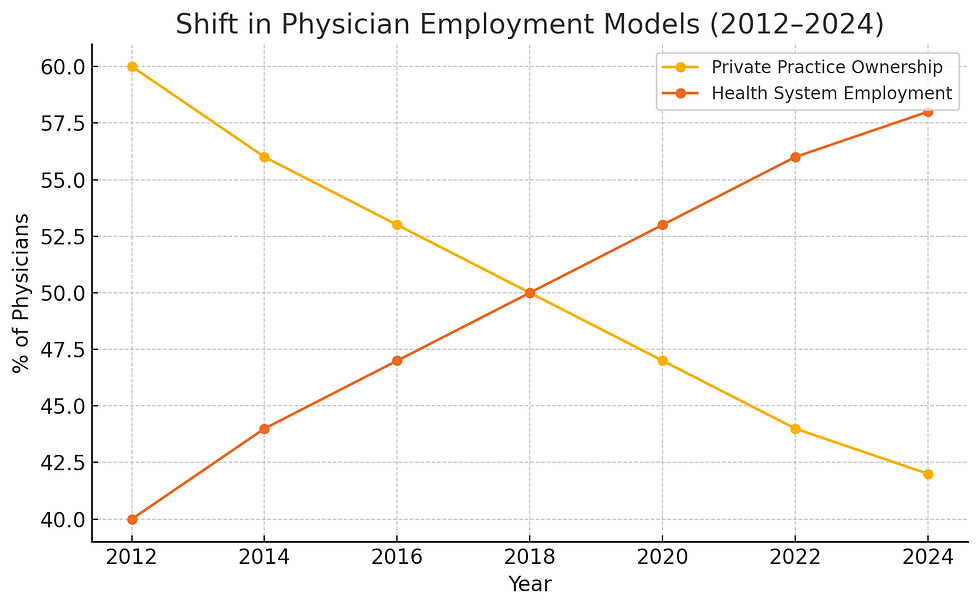The Role of Private Practices in Today’s Healthcare System: Past, Present & Future
- Alex.Nedzelskiy@sloanmed

- Jul 20
- 2 min read
The Role of Private Practices in Today’s Healthcare System: Past, Present & Future
By Sloan Medical RCM – July 20, 2025
When people picture the heart of healthcare, they often imagine a white coat, a stethoscope, and a doctor who knows your name — not a 15-minute visit through a maze of hospital bureaucracy. That “heart” used to beat strongest in private practices. But in the last decade, the healthcare landscape has shifted dramatically. The question is: do private practices still have a place in this new system? And if so — what’s next?
A Decade Ago: Independence and Intimacy
Ten years ago, private practice ownership was still the norm. About 60% of physicians owned or worked in independently-run practices. These clinics were rooted in community care, often passed down through generations, and they offered something the big systems didn’t: control, continuity, and personalized relationships.
But cracks were already showing. Rising administrative burdens, increased regulation, and shrinking reimbursements made staying independent harder every year.
The Present: A Battle of Scale vs. Service

Fast forward to today: health system employment has surpassed private practice ownership. Over 58% of physicians are now employed by hospital systems or corporate entities. The appeal? Stable paychecks, fewer overhead headaches, and job security in a shifting economy.
But that comes at a price. Patients are complaining about shorter visits, less continuity of care and feeling like just another number in a massive system.
Meanwhile, private practices are fighting to stay afloat — with less leverage in payer negotiations and fewer resources for tech, compliance, and staffing.
Still, they’re surviving. Why? Because patients (and many physicians) still crave the autonomy, flexibility, and personal care only independent clinics can deliver.
Key Differences: Private Practices vs. Health Systems
Feature | Private Practices | Large Health Systems |
Autonomy | High — physicians run the show | Low — administrators dominate |
Care model | Continuity-focused | Efficiency & volume-focused |
Technology | Often lags due to cost | Centralized and well-funded |
Billing complexity | High (but manageable with support) | Lower (internal resources) |
Flexibility | Greater adaptability | Bureaucratic and slower to change |
What the Data Predicts: The Next 10 Years
Projections suggest consolidation will continue — but not without resistance.
A 2024 MGMA survey shows:
72% of private practices report increased patient demand post-COVID
63% say patients prefer them over larger systems due to personalized care
Younger physicians are starting to look again at entrepreneurship, especially in niche specialties
Analysts predict that while the total number of independent practices may decline slightly, those that remain will become stronger, leaner, and more strategic — often supported by outsourced RCM, virtual staffing, and tech-forward solutions.
Where Private Practices Can Win
Private practices won’t outspend the big systems — but they can out-care them. Here’s where the future is headed:
Hyper-local branding and community engagement
Efficient, outsourced billing + RCM to reduce overhead
Specialized services (like concierge, wellness, or direct primary care)
Flexible staffing using remote/virtual teams
Compliance + coding partners who actually understand their workflow
Final Thoughts: Not Dead, Just Evolving
To write off private practices is to misunderstand the core of medicine. Patients want connection. Physicians want autonomy. That demand isn’t going away — it’s just being reshaped by economic pressure and shifting expectations.
Private practice isn’t dying. It’s evolving — and with the right partners, tools, and strategies, like Sloan Medical RCM, it can thrive again.





Comments